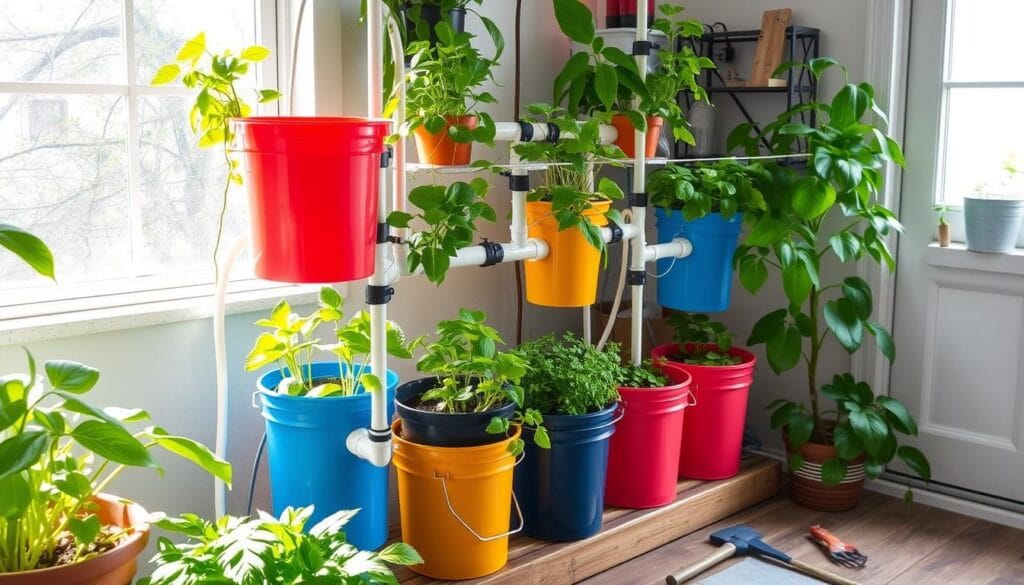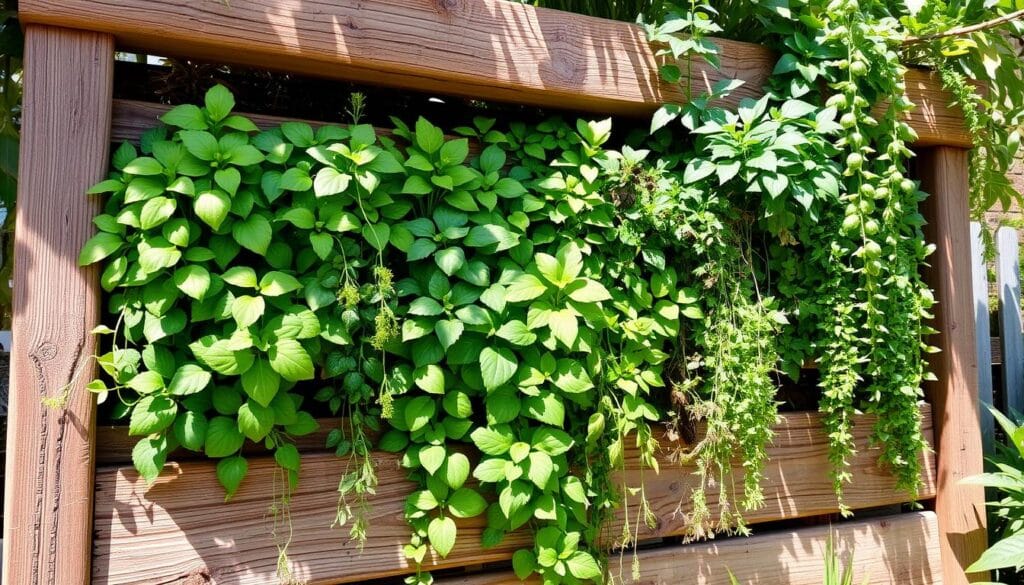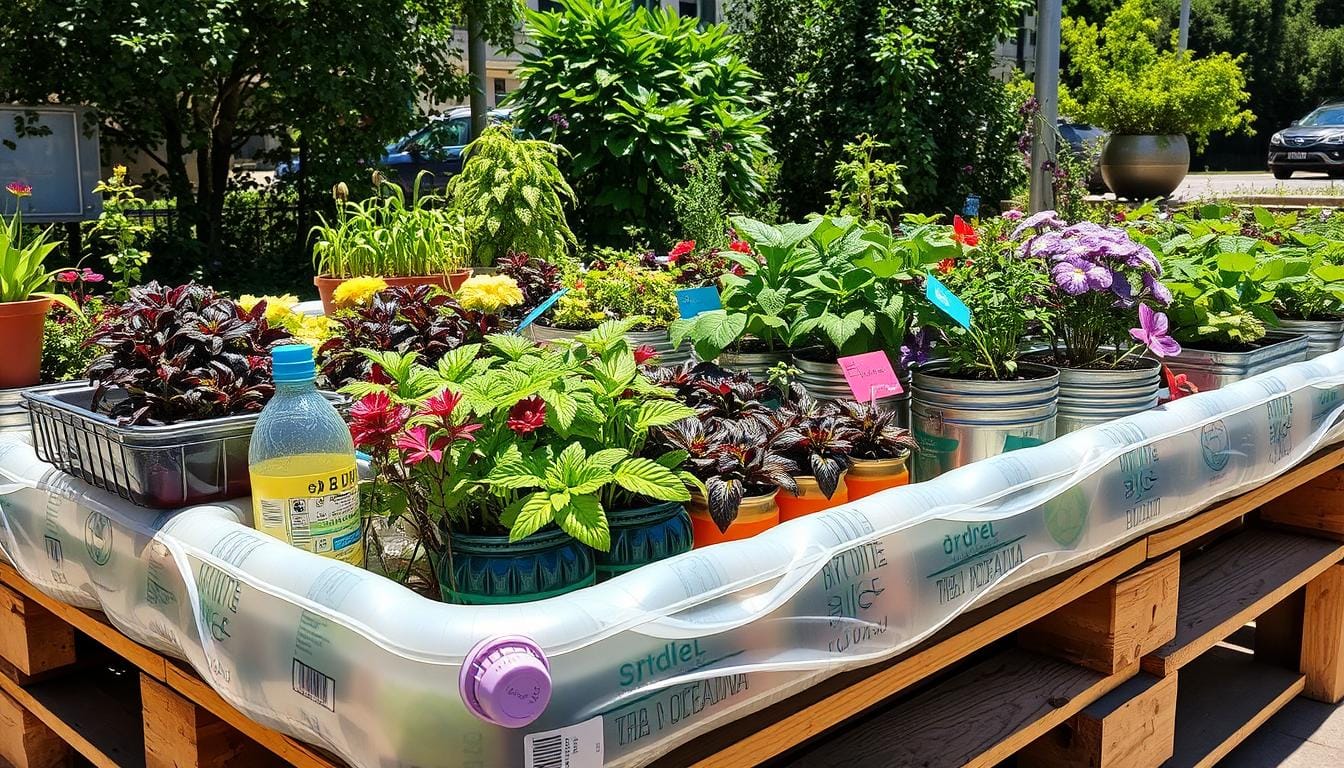Recycled materials can transform the way we approach gardening. As I looked at the hydroponic systems in the store, I felt uneasy. The prices and energy use made me think of a better way. I thought, why not use recycled materials for a hydroponic garden?
Using old items and recycled materials for a garden excited me. Hydroponics is good for plants and saves water. It’s also better for the planet. Plus, it saves money and cuts down on waste.
In this guide, I’ll show you how to make a hydroponic garden from recycled materials. It’s easy, whether you’re new to gardening or not. You’ll learn to grow plants well and help the planet at the same time.
Key Takeaways
- Hydroponic gardening offers faster plant growth and reduced water usage compared to traditional soil-based methods.
- Building a hydroponic system from recycled materials can significantly cut down the cost of purchasing a large hydroponic tank.
- Repurposing items like plastic water bottles can create a cost-effective and eco-friendly hydroponic setup.
- Hydroponic gardens can thrive in urban environments with limited space, making them an ideal solution for small-scale growers.
- The versatility of hydroponic systems allows for the cultivation of a wide range of plants, from herbs and vegetables to flowering plants and more.
Understanding Hydroponic Gardening Basics
Hydroponic gardening offers a modern approach to cultivating plants without the need for soil, relying instead on nutrient-rich water solutions. Instead, it uses water full of nutrients to feed the roots. There are two main types: water-based and medium-based systems.
Water-Based vs Medium-Based Systems
Water-based systems, like the Deep Water Culture (DWC), keep roots in the nutrient-rich water. This ensures plants always get the moisture and nutrients they need. Medium-based systems, on the other hand, use materials like clay balls or coconut fiber to support the roots.
Benefits of Soilless Growing
Hydroponic gardening has many benefits. Hydroponic gardening uses up to 90% less water compared to traditional methods. Plants grow faster and yield more as they receive nutrients directly from the water solution. It’s also great for urban environments and small spaces because it’s flexible and can be set up in tight areas.
Essential Nutrients for Hydroponic Plants
Hydroponic solutions have 17 essential elements for plant growth. These are divided into macronutrients and micronutrients. This balanced mix helps plants grow well and reduces the need for pesticides, making the produce healthier.
By exploring hydroponics system, soilless growing, and urban gardening, you can grow your own fresh, sustainable food. This is possible even in small spaces.
DIY Hydroponic Garden with Recycled Materials
Start your own upcycling projects and make a homemade hydroponics system from old stuff. This green way not only cuts down on waste but also helps communities with less resources. You can make a lush sustainable gardening spot indoors, all while saving money.
DIY hydroponic gardens have lots of perks. They use way less water than regular gardens, which is great for areas with little rain. Plus, they save space, letting you grow many herbs and veggies all year, no matter the weather. Your homemade hydroponics setup will be a clean, green space.
- Look around your house for things like plastic bottles, buckets, or old bins to use as planters.
- Choose simple, cheap, and flexible systems like the Kratky method or deep water culture for your DIY project.
- Keep an eye on pH levels, light, and temperature to make sure your plants grow well.
By using upcycling projects, you can grow a great homemade hydroponics garden. It will feed your family and help the planet. Enjoy the fun of sustainable gardening and see the potential in things you might throw away.
“Hydroponic gardening revolutionizes how we grow fresh produce, enabling year-round cultivation while significantly reducing environmental impact. The possibilities are endless when you combine sustainability and creativity.”
Selecting and Preparing Recycled Containers
Creating an eco-friendly, recycled materials crafts hydroponic garden starts with the right containers. Repurposing items you have can reduce waste and make your garden unique and beautiful.
Best Types of Containers to Repurpose
Choose containers that are sturdy, fit your plants well, and can be changed easily. Good options include 5-liter water bottles, large sauce jars, and glass bottles. With a bit of work, these can become great hydroponic systems.
Cleaning and Sanitizing Methods
It’s key to clean and sanitize any recycled container before use. This step is vital for a safe, healthy space for your plants. Use a mild detergent, rinse well, and then disinfect with bleach or a sanitizing product.
Creating Proper Drainage Systems
- Drill 4 holes, about 3-4 cm from the bottom, to allow for proper drainage.
- Consider adding a layer of gravel or pebbles to the bottom of the container to further improve drainage and air circulation.
- For clear containers, consider painting the outside with a waterproof paint to block light and prevent algae growth.
By choosing and preparing your recycled containers well, you’re on your way to a thriving, upcycled hydroponic garden. It will be both eco-friendly and eye-catching.
Creating a Dutch Bucket System from Used Materials
Using recycled materials, the Dutch bucket hydroponics system is a green way to grow your own food. It’s great for growing vine crops like tomatoes and cucumbers. This method uses a drip irrigation system, also known as the Bato bucket system.
To start your Dutch bucket garden, you’ll need some basic items. These include recycled buckets, PVC pipes, tubing, a water pump, a reservoir, growing medium, and nutrient solution. This setup is both affordable and eco-friendly, working well for small gardens or big commercial farms.
The Dutch bucket system is simple and can grow in size. Each plant has its own bucket, allowing for precise control over growing conditions. This guarantees healthy plant growth and higher yields.
This system is also good for the environment. By using old buckets, you reduce waste and lower your carbon footprint. It’s an excellent choice for individuals committed to sustainability and environmental care.
Whether you’re new to gardening or have experience, the Dutch bucket system is easy to use. It lets you grow many types of plants using recycled materials and modern hydroponics. This way, you can have a garden that’s both sustainable and full of fresh produce.

Want to know more about starting your Dutch bucket hydroponics system? Check out our detailed guide on recycled bucket garden and sustainable growing system solutions. With some creativity and the right information, you can turn any space into a lush garden full of fresh, healthy food.
Setting Up Your Hydroponic Growing Medium
Choosing the right growing medium is key for a healthy hydroponic garden. It provides nutrients, supports roots, and keeps moisture levels right. Let’s look at different media options, how to prepare them, and the best depth for a successful indoor garden.
Types of Growing Media Options
Perlite, expanded clay (LECA), and coconut coir are common choices. Each has its own benefits for your plants and setup.
Media Preparation Techniques
It’s crucial to prepare your growing medium well. Start by cleaning and rinsing it to remove dirt and harmful substances. This ensures your plants stay healthy.
Optimal Media Depth Guidelines
When setting up, consider the right depth for your medium. Start with a layer of gravel or LECA at the bottom. This aids in proper drainage and ensures adequate aeration for the roots.
Then, add net pots or plant baskets with your chosen medium. The best depth varies by plant, but 6 to 12 inches is usually good for root growth and nutrient uptake.
By picking and preparing the right growing medium, you can create a vibrant indoor garden. This setup boosts water efficiency, nutrient delivery, and plant health.
Building an Efficient Irrigation System
Creating a good irrigation system for your hydroponic garden is key. It makes sure your plants get the right water and nutrients. You can make a DIY drip system from recycled stuff. It saves money and uses less water.
The Dutch bucket hydroponic system is an excellent option for efficient plant growth. It uses regular buckets for growing plants like tomatoes and cucumbers. It works well for both small gardens and big farms, making it perfect for water-efficient gardening.
- Begin by using 2- to 5-gallon (5 to 20 liters) buckets as plant homes.
- Choose 1-inch (20mm) PVC pipes for the feeder and 2-inch (50mm) for the drain.
- Connect 1/4-inch (5mm) tubing to the feeder for a DIY drip system.
- Add a water pump, timer, reservoir, and nutrient solution to finish your hydroponic irrigation setup.
To keep your system running well, check the pH and EC of the nutrient solution often. Also, clean the parts to stop algae. Make sure your plants get enough sunlight or grow lights for best growth.
“The Dutch bucket hydroponic system is a versatile and efficient method for growing various plants, optimizing yields in agriculture.”
Building a water-efficient irrigation system from recycled stuff is smart. It makes a healthy hydroponic garden that’s good for your wallet and the planet.
Essential Nutrients and Water Management
Keeping the right balance of nutrients and managing water well is key for a successful hydroponic garden. Use a nutrient solution guide, watch pH levels, and save water to make sure your plants grow well. This way, your garden will be both nutrient-rich and water-efficient.
Nutrient Solution Mixing Guide
It’s important to follow the maker’s guide for hydroponic nutrients closely. The best N-P-K ratio changes based on what you’re growing. Experienced growers often mix their nutrients to get the best growth and yields.
Using chelated nutrients helps your plants get nutrients better, no matter the pH. Check the Electrical Conductivity (EC) of your solution to make sure it’s just right. This guarantees that your plants receive all the essential nutrients they require.
pH Monitoring and Adjustment
Keeping the pH right is key for your plants to take in nutrients well. The optimal pH range for plant growth is between 5.5 and 6.5. Some nutrients need a bit different pH to work best.
Using automated pH and EC systems makes things easier. It saves you time and makes your garden more efficient. Always check and adjust the pH of your solution to keep your plants healthy.
Water Conservation Techniques
Hydroponics save a lot of water compared to growing in soil. By recycling excess solution, you use less water. This helps you save water and use it better.
Flushing the system with plain water helps avoid salt and nutrient problems. Keep an eye on pH, EC, and nutrient levels to make sure your plants get what they need.
“A successful hydroponic system relies on essential components like reservoirs, grow trays, nutrient solutions, adequate aeration, and appropriate growing media.”
By following these tips, you can make a hydroponic garden that’s efficient with water. It will help your plants grow well and give you great yields.
Sustainable Plant Support Systems
Maximizing your vertical gardening space is key. Sustainable plant support systems are essential. Using recycled materials helps create a space-efficient growing environment. This supports your plants and follows urban agriculture principles.
Bamboo stakes or repurposed trellises are great for vine crops. These natural materials offer strong support. They let your plants climb, saving space for other crops. Plus, you can customize these DIY systems for your hydroponic garden.
For a green and attractive option, try using recycled items. Old wire frames, wooden pallets, or discarded ladders work well. These materials add charm to your garden and make it more sustainable.
| Plant | Estimated Growth Time in Hydroponics |
|---|---|
| Basil | 4–6 weeks |
| Mint | 3–4 weeks |
| Parsley | 5–6 weeks |
These space-efficient growing methods help your urban agriculture thrive. They make the most of your space and reduce environmental harm. Use recycled materials to support your plants and enhance your hydroponic vertical gardening project.

Monitoring and Maintaining Your System
To keep your hydroponic garden thriving, you must watch it closely and maintain it regularly. It’s crucial to check important system parameters and do upkeep tasks often. This helps maintain your plants’ health, promoting vigorous growth and sustained productivity.
Monitoring Nutrient and Water Levels
Check the pH and electrical conductivity (EC) of your nutrient solution often. The pH should be between 5.5 and 6.5. The EC should be between 1.0 and 2.5 mS/cm for most plants. Adjust the nutrients as needed to keep growing conditions perfect.
Preventing Algae and Contamination
To stop algae and contamination, clean your hydroponic system parts regularly. Scrub the reservoir, tubing, and other surfaces to remove any buildup.
Ensuring Proper Lighting and Climate
Your plants need the right light, temperature, and humidity for growth. Keep the air temperature between 70°F and 80°F (21°C – 27°C). Humidity should be between 40% and 60%. Give your plants 16-18 hours of light daily for seedlings and 12-14 hours for mature plants.
Integrated Pest Management
Check your plants often for pests or disease. Use an Integrated Pest Management (IPM) strategy to handle any problems. This might include introducing beneficial insects, using organic pest control, or adjusting the environment.
Establishing a Maintenance Routine
- Daily tasks: Check pH, EC, and water levels; monitor plant growth
- Weekly tasks: Clean system components; adjust nutrient solution
- Monthly tasks: Perform a comprehensive system inspection and maintenance
By watching your hydroponic system closely and doing regular maintenance, you can keep your plants healthy and productive. This also supports sustainable gardening practices.
| Parameter | Optimal Range |
|---|---|
| pH | 5.5 – 6.5 |
| Electrical Conductivity (EC) | 1.0 – 2.5 mS/cm |
| Water Temperature | 65°F – 75°F (18°C – 24°C) |
| Air Temperature | 70°F – 80°F (21°C – 27°C) |
| Humidity | 40% – 60% |
| Lighting | 16-18 hours for seedlings, 12-14 hours for mature plants |
“Consistent monitoring and maintenance are key to ensuring the long-term health and productivity of your hydroponic garden.”
Conclusion
Creating a DIY hydroponic garden with recycled materials is a smart, green way to grow your own food. The Dutch bucket system makes it easy to enjoy the perks of hydroponics. These include faster plant growth, less water use, and a smaller environmental footprint.
Turning plastic buckets into a garden is a great way to go green. It works for both seasoned gardeners and beginners. This method lets you try out eco-friendly gardening and get more from your space.
When starting your hydroponic garden, keep an eye on nutrients, pH, and water. With the right care, your garden will give you a lot of fresh, tasty food. Use recycled materials and green gardening to make a garden that’s good for the planet.

